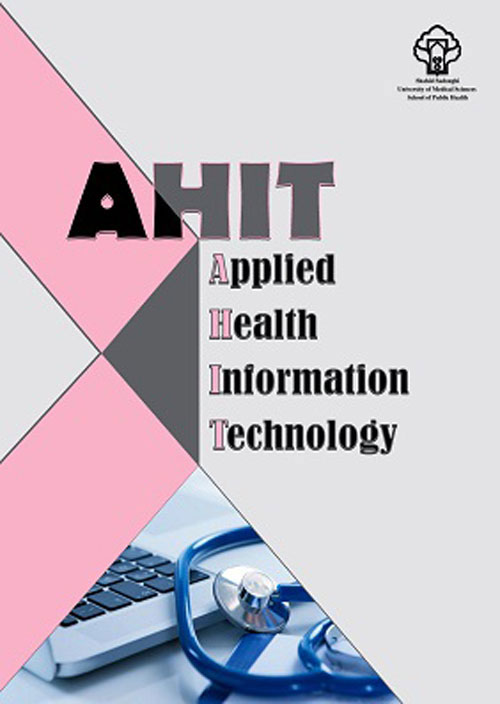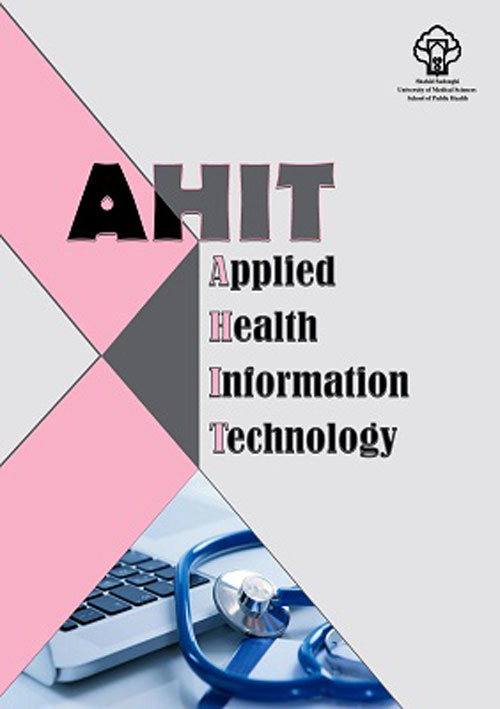فهرست مطالب

Applied Health Information Technology
Volume:2 Issue: 1, Winter-Spring 2021
- تاریخ انتشار: 1400/03/10
- تعداد عناوین: 8
-
Page 1
In the healthcare industry, every effort is made to increase life expectancy and the quality of life. Inevitably, with increasing life expectancy, one of the ways stations of life is old age, and the important challenge in this station is to increase life quality (1). With the advent of the COVID-19 pandemic, as a crisis, which changed all lifestyle patterns, the elderly population suffered the most and made many sacrifices (2). Given that the old age is associated with chronic diseases require constant care, and according to global warnings to strict observance of health protocols in controlling Coronavirus disease 2019, older adult should be prioritized in receiving health care services and medical care, with minimal attendance at communities and health care centers (3). Electronic interventions in the form of information technology applications could play an important role in the field of health (4). In this way, a variety of information technologies such as mobile health, telemedicine, and home care could be used to prevent and control Coronavirus disease (COVID-19) in the most at-risk populations such as older adults. These technologies include performing diagnostic tests, monitoring fever through smart wearables, monitoring blood sugar level, monitoring blood pressure, providing online counseling, visits, and training (5(. However, as a country with an aging population, what is important in Iran is whether or not the necessary technological infrastructure is provided to maintain and improve older adults' health in the midst of the COVID-19 crisis or another similar crisis in the future
-
Pages 2-10AimTo determine the MIL level among postgraduate students of Zahedan University of Medical Sciences.MethodThis descriptive-analytical research was conducted among 490 postgraduate students in 2020 at a medical sciences university. The data collection tool was a questionnaire that was used before in previous studies. The link of the web-based questionnaire was placed in the student's groups on WhatsApp social media, and was asked to complete it to collect the data. Finally, 227 questionnaires were completed and collected. Data analysis was performed using SPSS statistical software. Descriptive and analytical statistics were used to analyze the data.ResultsThe mean score of MIL was moderate. Among the factors related to MIL, the "use" factor obtained the highest means score (3.80±0.50), and the "evaluation" factor obtained the lowest mean score (2.54±0.84). There was a significant relationship between the MIL of students and their gender, age, school, and level of family income. "Learn new content," "earn a good grade, pass a course or upgrade your academic rank,"; and "writing in a way that leads to new knowledge" obtained the highest mean scores among the options. The lowest mean scores were related to "pay attention to the author's reputation (for example, his work experience, degree or place of work)"; "paying attention to the reputation of a publisher or media producer," and "Pay attention to which organization supervises the distribution and dissemination of the intended media and what are the rules about it?"ConclusionSince the students were studying at the postgraduate level, it requires special attention to improve their literacy level. University officials should hold classes and workshops, and even conferences on topics related to the evaluation of media and information, including critical thinking, problem-solving, questioning, and identifying credible media resources to improve the level of MIL of students.Keywords: Media, Information literacy, Students, University, Technology
-
Pages 11-19Aim
Since the readiness study is considered a basic step in implementing various technologies, this study was conducted to assess the readiness of Al-Zahra Ophthalmology Hospital for implementing RFID technology.
MethodThis descriptive cross-sectional study was conducted in Al-Zahra Ophthalmology Hospital in Zahedan (the eastern province of Iran). Personnel of departments including emergency, management, information technology, and health information management formed the research population. A researcher-constructed questionnaire was used for data collection. The questionnaire consisted of two parts with 37 questions for assessing the hospital readiness and the barriers of using RFID technology. Data were analyzed by SPSS software version 23.
ResultsThe mean scores of humans, technical and organizational readiness of Al-Zahra Hospital for RFID technology were: 29, 45.14, and 33.5, respectively. In other words, technical readiness was assessed at a good level and human and organizational readiness at a moderate level. The overall readiness of Al-Zahra Hospital for RFID technology has been at a moderate level (mean score of 35.88). The mean score of barriers to using RFID technology was 37.82.
ConclusionBased on the findings, although there are positive points about RFID technology in terms of technology acceptance, organizational and technical issues, the lack of technical manpower, radio waves equipment, and budget are among the major challenges of RFID technology implementation in Al-Zahra hospital. Therefore, allocating the budget and employing specialized human resources, and creating the necessary technical infrastructure are necessary for implementing RFID technology.
Keywords: Feasibility, Hospital, Health plan, Implementation, Radio frequency identification device -
Pages 20-29Aim
This study aimed to assess the usability of HISs from users' viewpoints based on ISO 9241-10 standard.
MethodsThis study was a descriptive and cross-sectional study that was conducted in 2019. It was filled out by 227 end-users, including 165 clinical and 59 administrative staff of Imam Khomeini, Mostafa Khomeini, and Taleghani hospitals selected randomly. Data were collected using the standard Iso-Metric 9241-10 questionnaire. The content validity and reliability of the questionnaire were assessed by experts' opinions and test-retest method, respectively. Finally, the findings were analyzed using descriptive statistics (mean value, standard deviation, and frequency) through SPSS-23 software packages.
ResultsBased on the results, 56% of HISs users in the surveyed hospitals were somewhat satisfied, with the total average of all scores being equal to 2.8 from 5. The results suggested that the highest scores were found for the criterion of "controllability," while the lowest scores were associated with "suitability for individualizations" and "self-descriptiveness," respectively.
ConclusionThe HISs users' satisfaction was considered relatively desirable in terms of functionalities factors. Therefore, user-friendliness, flexibility, and web-based capabilities are suggested as the most important requirements that must be taken into account for enhancing usability and adoption of HISs.
Keywords: Hospital information system, Evaluation, ISO 9241, 10, Standard -
Pages 30-38AimThis study investigated physical education (PE) instructors' attitudes and practices of information technology (IT) for information-seeking behavior (ISB).MethodThis cross-sectional study carried on eighty-eight PE instructors from three universities. The 36-item online questionnaire was designed electronically for measuring instructors' attitudes, IT use for ISB, and information-seeking (IS) methods. The analyses conducted for descriptive statistics involved reporting response frequency, percentages, means, and standard deviations for the attitude sections. Mean scores for attitude and use factors were used to conduct a two-tailed Pearson correlation analysis. SPSS-23 was used for analysis.ResultsThe findings indicated that participants generally had positive attitudes about technology use for ISB. Significant relationship exists between participants' perceptions of relevance/importance of IT use for IS (r = .565, p < .01). Also, a positive correlation was found between instructors' perceptions of relevance/importance of IT and physical instructors' IS methods (r = .536, p < .01).ConclusionBased on the current study, physical instructors may be willing to apply IT for IS if given opportunities to participate in searching databases workshops and practice and utilize appropriate information resources.Keywords: Physical education, Information-seeking behavior, Information technology
-
Pages 39-50AimAccurate information can be accessed in a timely manner through the Integrated Mental Health Information Network (MHIN). As Iran has no MHIN, this study was undertaken to propose an architectural model.MethodThis research is a sequential mixed method. The organizational structure and database structure of the MHIN was identified, and the architectural model of the NMHIN was presented in two main phases. In the first phase, a quantitative study was conducted in a scoping review with an extensive review of the background, documents, information, and available resources about the mental health information network. In the second phase, to validate the proposed architecture, the Delphi technique was implemented. Questionnaires were distributed and collected both in person and by e-mail, and finally, the data were analyzed using SPSS-19.ResultsThe model of national MHIN was provided in five dimensions: MH entities, organizational ownership of databases, data elements of each database, linkage among databases, and exchangeable data elements among the databases.ConclusionThis model can be applied as a suitable platform to effectively and efficiently store and use mental health information. So, the available information can be used for providing mental health services more comfortably and appropriately. The results showed that connecting mental health entities can create a flow of information, coordinate MHIN activities, and improve performance, efficiency, and quality of mental health.Keywords: Mental health, Mental health information network, Architecture, Model
-
Pages 51-57
In an objective sense, security measures the absence of threats to acquired values, whereas, in a subjective sense, it refers to the absence of fear that such values will be attacked. Bioterrorism is a threat. Therefore, any threat to the country's vital goals and security components, such as population, land, and property, is a national security threat. Establishing a robust information system is critical for detecting Bioterrorism outbreak, which is considered a threat to national security. Real-time surveillance and monitoring, fast communication, data collection, and analysis at the regional and national level are the main functions of this information system. Early detection of bioterrorism is an important step in national security promotion. If the BIS is appropriately designed based on critical factors such as multidimensional, real-time, manage by the security agency, and have the capability for pattern recognition and detection, it will more effectively manage bioterrorism attacks by relying on its capabilities, features, and technologies. Therefore, this study investigates the features and capabilities of the Bioterrorism Information System (BIS) in national security improvement and promotion.
Keywords: Information systems, Bioterrorism, Bio-surveillance, Security, Disease outbreaks -
Pages 58-66
This article addresses this important issue that medical sciences universities are an organization that is rich in intellectual capital in various fields and specialties and also have multiple customers and segmented markets. Therefore, it is necessary to establish a connection between these assets and innovation by properly managing the intelligent capital and identifying the society’s needs. It should also avoid continuing to educate academic fields that are no longer needed by society and try to replace them with ones that are appropriate to the needs of society to save its tangible capital. This means that education is accountable for the needs of society. This will not happen unless establishing a continuous and strong connection between the university and industry.
Keywords: Intellectual capital, Innovation, University, Accountable education, Society


